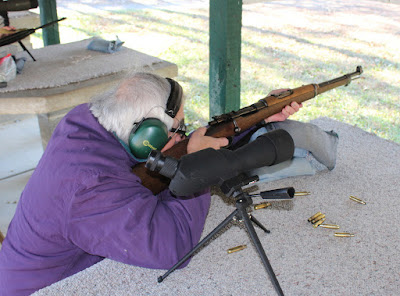Today company came from Virginia in the form of Stretch, and he, Bruce, Proud Hillbilly and I hit the range on a cold November morning.
Here's Stretch with his M1A
Bruce, with the 1916 Spanish Mauser that I sold him after buying it back from the last guy I sold it to. (And it shoots great. What was I thinking?)
PH with her little PH-sized Carbine.
I brought out this Enfield #1Mk3, one of the three that I bought a few months ago from a neighbor down the street.
This is one of the ones that I'm in the middle of refurbishing. It's a straight Mk3, not a Mk3* like most of the ones out there today are.
Made in 1912. Cool, eh?
As such, this one has all the neat sutff that they left off of the Mk3*.
It has volley sights. This was a dumb idea that was intended to let a whole company of riflemen put rounds on a large target--another company of riflemen--up to 2800 yards away.
It didn't really work, and it was eliminated from the rifles by 1916.
It also has a magazine cut-off, another dumb idea of the time. The British army was transitioning from single-shot rifles to magazine-fed repeaters, and the generals who grew up with the old rifles felt that their soldiers would waste ammunition if allowed to fire from the magazine, so this cut-off was put on the rifles to block the magazine. The idea was that with the cut-off in place, the soldiers would still fire the rifle single-shot and conserve ammunition, but when it came time to charge, or if they were being attacked, they could open the cut-off and then use the whole ten-round box.
Yeah, it was dumb. And the US Rifle ,30 Model 1903, aka: the '03 Springfield, had the same cut-off on it's five-round magazine.
1903 Springfield cut-off.
This one also has a fully adjustable rear sight instead of the later elevation-only rears. This was not a dumb idea.
Looking over this rifle, someone was apparently unclear on the concept of the windage-adjustable rear, because they drifted the front sight post. Now I have to remove the nose cap and try to hammer it back where it's supposed to go. But as-is, I was still able to keep my rounds in the nine-ring (4x6") of the target I was firing on at 100 yards...that is until I started getting cold, at which point my accuracy fell off noticeably.
All in all, I'm happy with this one, though. And I'd fight with it if I had to.
It even has a unit-marked ID disc on the stock, dated June of 1912. No idea what NIH stands for though.
Only real "flaw" (if you view it as such) is that it now has a light spot on the left side of the buttstock where I had to sand it down and refinish it with Linseed oil.
The neighbor that I got this from had a house fire some years back and this rifle's stock was scorched. I got it cleaned up but had to take the wood down a fair bit to get past the charring. Scary to think how close this old matching-number, non-import marked vet came from being destroyed in that fire. But she still looks good, and shoots well enough that I'd use it in a foreign service-rifle match any day. Just let me get the sights re-aligned right and she'll be quite the shooter indeed.














Very nice. I've got a soft spot for Enfields, good job on saving that one.
ReplyDeleteAlso NIH could be the North Irish Horse Regiment, which would make that a very cool relic indeed.
ReplyDeleteI concur Aaron.
Delete+1 on the North Irish Horse, according to this handy-dandy guide to Lee-Enfield manufacturer's marks.
ReplyDeleteThanks, Aaron and Bob.
ReplyDeleteThis blog has some of the best readers. :-)
Hey Murphy;
ReplyDeleteAwesome selection of rifles, and you done good saving that Enfield. As far as the magazine cut out went, the old British generals still believed in the Wellington traditions of"Give them a couple of volleys, then finish them with steel in the gut." kinda archaic with the influx of various weapons that have already appeared on the battlefield in America, the Boer wars and the Zulu insurrections and the American vs Spain kerfluffle in 1898 from machine guns and accurate repeating rifles...A good day at the range is a good time:)
Nicely done!
ReplyDeleteSo very cool... Beats my oldest by 4 years... Maybe I'll bring that to next years shoot and see how it compares. And an even bigger bonus on the no foolin date correct ID disc....Love holding history in the hands...
ReplyDeleteGlad y'all got a day at the range! :-)
ReplyDeleteSweet!
ReplyDeleteYou are performing a noble task, refurbishing the old classics.
ReplyDeleteThat's a hard core bunch of shooters, going out in that weather.
That Bruce guy is adorable ! And, I hear he isn't a bad shot either.
ReplyDeleteNice North Irish Horse SMLE. 629 is probably the original owner's regimental number (No.629 would have enlisted in November 1911).
ReplyDeleteMind if I add some of the pics to my NIH website? (www.northirishhorse.com.au)
Nice North Irish Horse SMLE. The 629 on the disc is probably the Regimental Number of the original owner (No.629 enlisted in November 1911).
ReplyDeleteMind if I use some of your pics on my NIH website?
(www.northirishhorse.com.au)
Use anything you find here. All I ask is attribution.
Delete